Apec: Aspirations, but no action
What did the $270m Sydney summit really achieve?

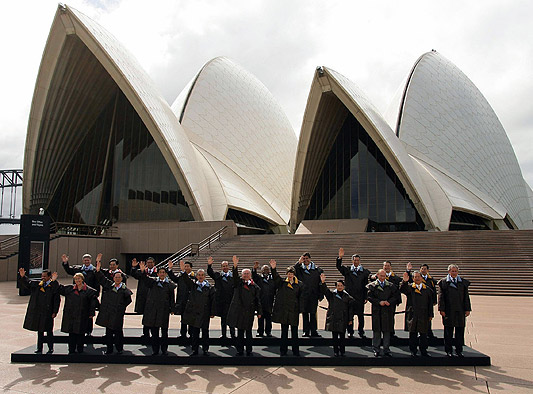
Apec was meant to focus on trade, but has made little progress even on that issue [Reuters]
Keep reading
list of 4 itemsTurtles swimming to extinction in Malaysia as male hatchlings feel heat
Could shipping containers be the answer to Ghana’s housing crisis?
Thousands protest against over-tourism in Spain’s Canary Islands
Another Apec summit has wrapped up with a leaders’ declaration very similar to years before, full of hope and promise, to address climate change and free up global trade.
John Howard, the Australian prime minister and summit host, described it as a “statement of very strong support” for the much-delayed – some say dead – Doha round of world trade talks.
Apec was first envisioned in Australia back in 1989. As its full name implies, the main focus of the Asia-Pacific Economic Cooperation forum was meant to be trade.
The first big Apec promises came in 1994 in the Indonesian city of Bogor, where members set out goals for achieving free trade – by 2010 in developed countries and by 2020 in developing nations.
In the years since, there have been almost annual statements reaffirming members’ commitment to what have become known as “the Bogor goals”.
Sidelined
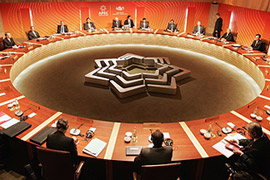 |
| Despite much talk, Apec is far from achieving its original aims [GALLO/GETTY] |
But as the group has developed, its annual summits have often been dominated by issues of the day, with trade pushed to the sidelines.
Malcolm Cook, Asia-Pacific programme director at Sydney‘s Lowy Institute, says that after a lot of talk and grand plans, Apec is still far from achieving its original aims.
“When you look at what Apec set out to do when it was first set up, the Bogor laws called for free trade and investment by 2010. 2010 is just around the corner and we’re nowhere close to that,” he told Al Jazeera.
“If you look at Apec as a series of outcomes where you can say ‘Apec changed the world this way’, then one could be easily disappointed.”
One of the thorniest trade issues in recent years has been the Doha round of world trade negotiations that began in 2001, which deals with agricultural subsidies and industrial tariffs.
With Apec economies accounting for almost 50 per cent of global trade, it would seem that the 21-member group would be ideally placed to help resolve the stumbling blocks.
In 2005, leaders urged that “the Doha round must be carried to a successful conclusion”.
‘Close to dead’
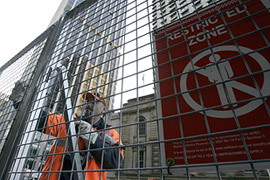 |
| Much of central Sydney was locked down for the summit [Reuters] |
Meeting a year later in Hanoi, leaders again proclaimed “the Doha Development Agenda remains a top priority of Apec” and that they were “ready to break the current deadlock”.
Yet another year on, it seems Doha is still no further forward.
Pascal Lamy, Director General of the World Trade Organisation, insisted in Sydney the Doha talks were not at an impasse, although he did concede that the World Trade Organisation was “not in the final game of concluding the negotiations”.
Some analysts go much further.
“If it’s [Doha] not dead, it’s in a coma and looks like somebody might pull the plug,” says Malcolm Cook of the Lowy Institute. “So I think it’s very close to dead.”
And so, with little hope for progress on trade, to the other big issue of the day – climate change.
‘Aspirational’ goals
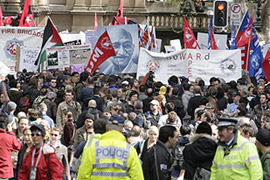 |
| Tight security prevented protesters from getting close to the meeting venue [Reuters] |
Long before the leaders of the 21 Apec economies touched down in Sydney, Australia‘s prime minister had made it clear he wanted climate change to top the agenda.
Accused of dragging his feet on the issue and facing an election later this year, Howard appeared eager to finally pin his environmental colours to the mast.
With its tiny population of around 21 million, Australia is one of the largest per capita emitters of carbon dioxide.
And like the US, it did not sign the 1997 Kyoto Protocol which requires nations to reduce their greenhouse gas emissions by a specified amount.
But from the outset it was clear that Howard was not pushing for specified targets on carbon emissions like Kyoto but rather a set of ‘aspirational goals’, an aim met by scepticism by environmental groups.
Abigail Jabines of Greenpeace South East Asia says such a move is tantamount to setting back discussions on climate change by 10 years. What is needed, she told Al Jazeera, is concrete action.
“Climate change is such an urgent issue. We cannot just shrug it off or brush it off.”
Increasingly Apec officials acknowledge that climate change represents a potentially serious threat to economic growth, which is why it was being addressed in 2007.
But few in Sydney failed to notice the irony of the Apec business meetings being sponsored by two US-based gas guzzlers – oil giant Chevron and car-maker General Motors.
Missing ’emissions’
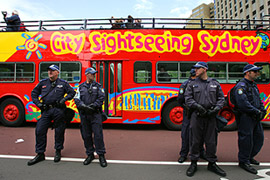 |
| Australia conducted its largest ever security operation for the summit [GALLO/GETTY] |
Adding to the scepticism is the conspicuous absence of the word “emissions” from the section of the Sydney declaration dealing with climate change.
Instead, Apec members agreed to work to reduce their “energy intensity” – the amount of energy needed to produce a dollar of gross domestic product – 25 per cent by 2030.
They also pledged to increase forest cover in the region by at least 20 million hectares by 2020, and strengthen collaboration into cleaner and renewable energy.
Malcolm Cook of the Lowy Institute says: “If you have Apec, especially the largest emitters – the US, China, Russia, Japan – sign up to an agreement like that, it would be hard to ignore at the global level.”
But other climate change experts and environmental activists were dismissive, saying the goals were non-binding and so modest in scope as to render the programme ineffective.
“In practical terms, that will mean almost nothing,” Frank Jotzo, an Australian National University expert in climate change economics told Al Jazeera. “It is very unambitious.”
Ultimately, whatever history eventually records about Sydney 2007, for most Australians the year Apec came to town will probably be remembered for the five-kilometre concrete and steel security fence, the inconvenience it caused Australia‘s largest city, and the $270m bill.